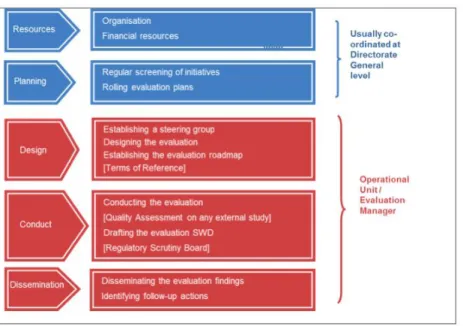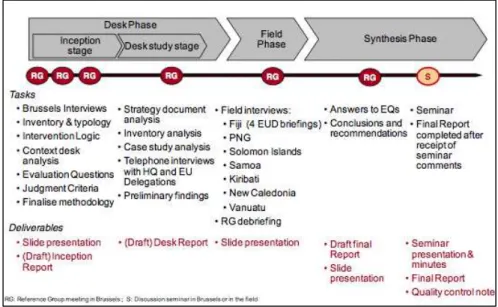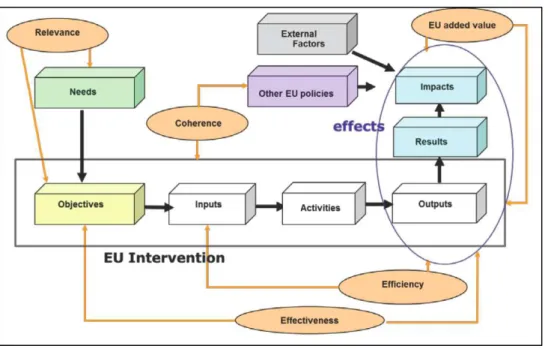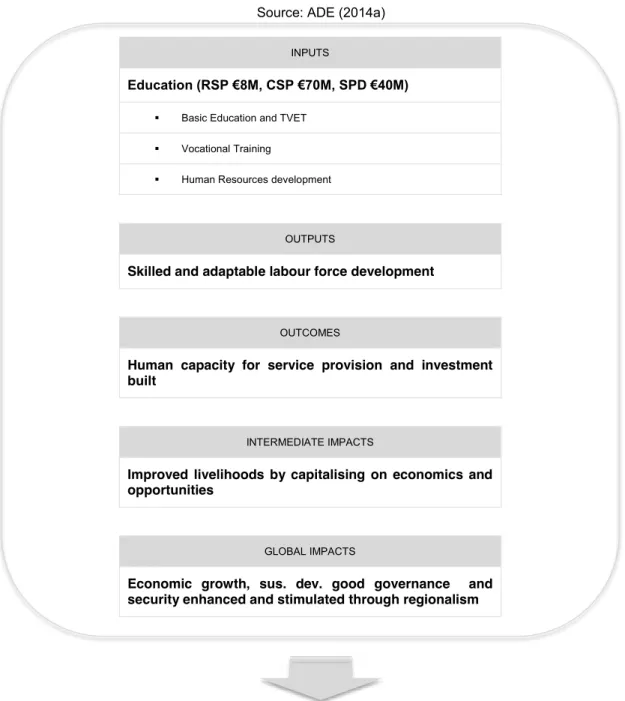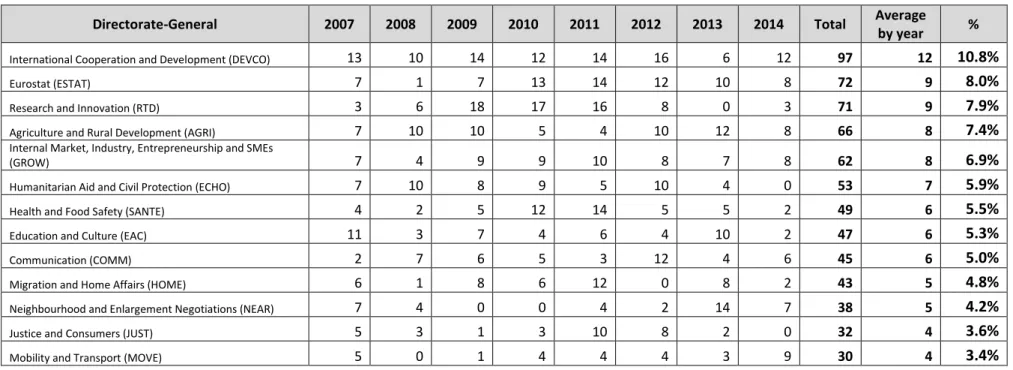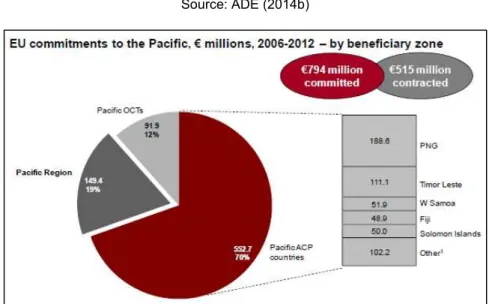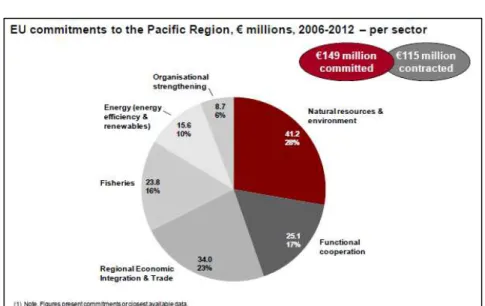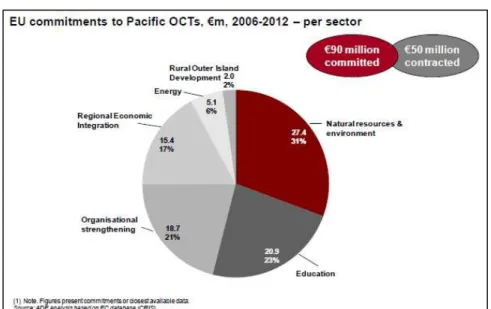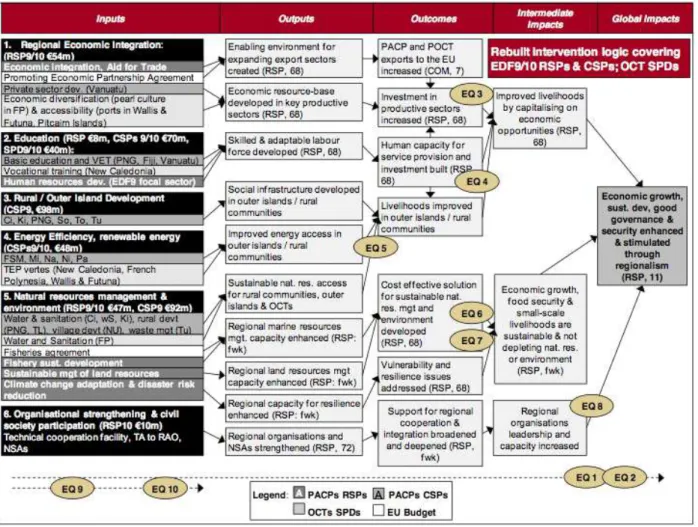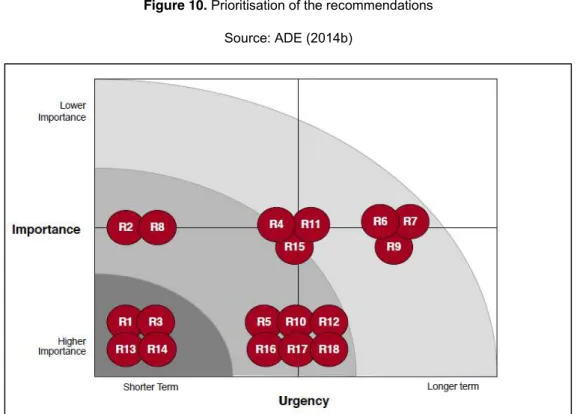M
ESTRADO
E
CONOMIA E
P
OLÍTICAS
P
ÚBLICAS
T
RABALHO
F
INAL DE
M
ESTRADO
R
ELATÓRIO DE
E
STÁGIO
E
VALUATION
S
YSTEM IN THE
E
UROPEAN
C
OMMISSION
-
DEVCO’
S
E
VALUATION
M
ETHODOLOGY
M
ESTRADO EM
E
CONOMIA E
P
OLÍTICAS
P
ÚBLICAS
T
RABALHO
F
INAL DE
M
ESTRADO
R
ELATÓRIO DE
E
STÁGIO
E
VALUATION
S
YSTEM IN THE
E
UROPEAN
C
OMMISSION
-
DEVCO’
S
E
VALUATION
M
ETHODOLOGY
V
ERA
D
ULCE
F
ERNANDES
M
ARTINHO
ORIENTAÇÃO:
P
ROFESSOR
D
R
.
P
AULO
T
RIGO
P
EREIRA
D
R
.
N
EIL
D
ILLON
Abstract
Over the last decades, the demand for evaluation has been growing and the
European Commission have had a major role in boosting evaluation practices in the
European Union (and its Member States) by successfully institutionalising an evaluation
system and establishing a comprehensive framework for the evaluation of its activities.
Although no common methodology has been defined within the European
Commission Directorate-Generals, common procedures are used across several
evaluation units and some guidelines were established among some of them that have
a longer the tradition in evaluation, notably DG DEVCO.
The evaluation process is long and complex, involves many stakeholders and
therefore the boundaries established by a clear and uniformed methodology enhances
the integrity and independence of the results. However, it also often causes the loss of
ownership, making more difficult the incorporation of the evaluation results into the
decision-making process.
Keywords: European Commission, Evaluation, DEVCO, Evaluation Methodology,
Resumo
Nas últimas décadas, a procura relativamente a estudos de avaliação tem sido
crescente e a Comissão Europeia teve um papel importante na dinamização de práticas
de avaliação na União Europeia (e os seus Estados -Membros), através da
institucionalização com sucesso de um sistema de avaliação e de um quadro conceptual
abrangente para a avaliação de as suas actividades .
Embora não exista uma metodologia única, procedimentos comuns são utilizados em
várias unidades de avaliação da Comissão Europeia e algumas diretrizes foram
estabelecidas entre as Direcções -Gerais que têm uma mais longa tradição em
avaliação, nomeadamente a DG DEVCO.
O processo de avaliação é longo e complexo, envolve muitos stakeholders e,
portanto, os limites estabelecidos por uma metodologia clara e uniforme permite aferir a
integridade e a independência dos resultados. No entanto, muitas vezes também
provoca a perda do sentimento de pertença pela mesma, tornando mais difícil a
incorporação dos resultados da avaliação no processo de tomada de decisão.
Palavras-Chave: Avaliação, Comissão Europeia, DEVCO, Metodologia de
Acknowledgments
I would like to express my gratitude to ADE, notably Edwin Clerckx, the managing director, Vincent Coppens, the head of the evaluation department, and to all the employees who have willingly shared their precious time and knowledge with me.
Furthermore, I would like to thank my supervisor at ADE, Dr. Neil Dillon, for introducing me to the topic as well for all the support on the way.
I would also like to thank to my supervisor at ISEG, Professor Dr. Paulo Trigo Pereira, for the useful comments, remarks and engagement throughout the entire process.
Table of Contents
Abstract ... 3
Resumo ... 4
Acknowledgments ... 5
Table of Contents ... 6
Table of Figures ... 7
Table of Tables ... 7
Acronyms ... 8
Context of the Internship ... 9
Host institution ... 9
Main activities and responsibilities ... 10
Introduction ... 12
1. EC’s evaluation system and policy ... 14
1.1. Structural organization ... 16
1.2 Evaluation process ... 17
1.3 General Overview of EC’s evaluation activities ... 19
2. EC’ Evaluation Process ... 22
2.1. Evaluation Phases (chronological approach) ... 23
2.2. Evaluation Methodology (methodological approach) ... 25
2.3. Methodology example ... 28
3. Description of activities ... 34
3.1. Evaluation activities ... 34
3.1.1. Literature review ... 35
3.1.2. Inventory ... 35
3.1.3. Cost-efficiency and cost-effectiveness analysis ... 37
3.1.5. Interviews ... 37
3.2. Other activities ... 38
3.2.2. Consultancy activities ... 38
4. Conclusion ... 40
References ... 42
Annexes ... 46
Annex I: Overview of the number of evaluations in the EC ... 46
Annex II: EU Pacific Cooperation Activities ... 49
Annex III: Intervention Logic ... 52
Annex IV: Evaluation Matrix ... 53
Annex V: Data Collection Grid ... 54
Annex VI: Findings, Conclusions and Recommendations ... 55
Table of Figures
Figure 1. Evaluation Process ... 18Figure 2. Evaluation Phases ... 23
Figure 3. The simplified intervention logic and the 5 key evaluation criteria ... 26
Figure 4. Effects chain in Education Sector (extraction from IL) ... 30
Figure 5. EU-Pacific Cooperation by beneficiary zone ... 49
Figure 6. Commitments to Pacific regional interventions by sector ... 50
Figure 7. Commitments to Pacific ACP countries interventions by sector ... 50
Figure 8. Commitments to Pacific OCT countries interventions by sector ... 51
Figure 9. Intervention Logic of the Evaluation of xxx ... 52
Figure 10. Prioritisation of the recommendations ... 56
Table of Tables
Table 1. Evolution of the number of evaluation per Directorate-General (2007-2014) ... 46Acronyms
ACP African, Caribbean and Pacific Group of States
ADE Analysis for Economic Decisions
ALNAP Active Learning Network for Accountability and Performance in
Humanitarian Action
CSP Country Strategy Paper
CTB Cooperation Technique Belge
CV Curriculum Vitae
DAC Development Assistance Committee
DEVCO International Cooperation and Development
DG Directorate-General
EC European Commission
ECG Evaluation Cooperation Group
ECHO Humanitarian Aid and Civil Protection
EDF European Development Fund
EIB European Investment Bank
EQ Evaluation Question(s)
EU European Union
GROW Internal Market, Industry, Entrepreneurship and SMEs
HQ Headquarters
IEG Independent Evaluation Group
IL Intervention Logic
ISG Internal Steering Group
JC Judgement Criteria
M&E Monitoring and Evaluation
NORAD Norwegian Agency for Development Cooperation
OCDE Organisation for Economic Co-operation and Development
OCP Overseas Countries and Territories
RIP Regional Indicative Programme
RSP Regional Strategy Paper
SPD Single Programming Document
TVET Technical Vocational Education and Training
UN United Nations
UNEG United Nations Evaluation Group
Context of the Internship
This report aims to account for the internship realised at ADE (Analysis for Economic
Decisions) within the study program of the Master in Economics and Public Policies at
ISEG (Instituto Superior de Economia e Gestão). The internship took place for a period
of 6 months (1040 hours), between 22/01/2015 and 31/07/2015, under the supervision
of both the professor Dr. Paulo Trigo Pereira from ISEG and Dr. Neil Dillon from the host
institution.
The internship aimed not only to develop a direct contact with professional practices
linked to the knowledge acquired during the Master’s Program but also to improve skills
of theoretical and methodological tools appropriate to approach concrete problems, in
this particular case in the field of monitoring and evaluation of public policies.
Host institution
1Created in 1990, ADE is a private consulting company based in Louvain-la-Neuve,
near Brussels, Belgium, that delivers objective and independent services to assist private
and public decision-makers in the formulation of rational economic decisions and in
monitoring their implementation. ADE intervenes at every stage of the decision-making
process: from problem analysis and advisory studies, to support in the formulation, in the
monitoring and in the evaluation of strategies/policies/programmes. ADE has a staff of
over 40 people, including a large number of in-house experts in various thematic areas
and in evaluation methodology.
ADE concentrates on four main areas of specialisation in which it has a recognised
reputation for excellence, and which it considers to be complementary and mutually
reinforcing:
Evaluation and monitoring;
Regional policies and innovation;
Economic policies and public finance;
Rural development and environment.
Evaluation at the level of aid programmes and public policies is at the heart of ADE's
range of activities. ADE has conducted more than 200 evaluations, including ex ante
evaluations, monitoring, mid-term and final/ex-post evaluations. They include also in
particular complex strategic evaluation, such as country-level, thematic and institutional
evaluations. ADE has also developed specific expertise in terms of support to developing
private sector developing countries, development finance, humanitarian aid, conflict
prevention and peace building.
ADE's main clients are international institutions and agencies (e.g. European
Commission, EIB, UN, World Bank) and national public institutions from both the EU
(e.g. Agence Française du Développement, CTB) and third countries (e.g. AfDB).
Through conducting these evaluations, ADE has developed and refined its
methodological and analytical tools and has become a recognised major player in terms
of evaluation, providing methodological support for evaluation in the following areas:
Development and promotion of evaluation methods and tools;
Advice on donors’ evaluation systems and knowledge management systems;
Dissemination of evaluation results by the organisation of seminars or participation in conferences;
Trainings in evaluation.
The internship took place in ADE’s Evaluation Department, which over the years has
been carrying out policy, strategy, programme and project evaluations, commissioned
by different type of clients, concerning different fields of expertise and conducted at
global, EU, regional, country and local level.
Main activities and responsibilities
2Being part of the Evaluation Department, the activities during the internship mainly
involved the production of inputs for the ongoing evaluations, particularly these
commissioned by the European Commission:
Evaluation of the EU blending mechanisms, commissioned by DG DEVCO
Evaluation of the EU cooperation with Pakistan, commissioned by DG DEVCO
Evaluation of the Use of Different Transfer Modalities in ECHO Humanitarian Aid Actions, commissioned by DG ECHO
Evaluation of the ECHO response to the Syrian crisis, commissioned by DG ECHO
Considering the length and period of the internship, there was the possibility not only
of being involved in almost all phases of these evaluations but furthermore to take part
in a diversified portfolio of activities which included also commercial work. Main activities
included:
Active research support on different evaluations including data collection, inventory management and reporting;
Quantitative and qualitative analysis, providing inputs for cost-efficiency and cost-effectiveness analysis;
Contribution to commercial activities, including support to proposal writing,
Introduction
Over the last 30 years the demand for evaluation has been growing tremendously
and evaluation practices have spread and become common in most OECD countries
(Højlund, 2014a).
The key actors in the field of evaluation are the World Bank, OECD, UN, multilateral
banks, the American Evaluation Association and the European Evaluation Society as
well as regional supranational political organizations such as the EU and some national
donor agencies (Furubo et al., 2002). They commonly reinforce the evaluation institution
through the production of guidelines as well as exchanges of opinions in public debates
and at evaluation seminars, courses and conferences (Højlund, 2014b).
By its nature, development and humanitarian aid programmes are important key
players in the evaluation field. The public and taxpayers increasingly demand credible
assessments of whether aid improves the lives of the world’s poorest (OECD, 2010).
In Europe, before the 1990s, except from some countries such as UK, Germany and
Sweden, most EU Member-States did not have a tradition in evaluation. Since then, the
development of an evaluation culture was influenced both by the EU regulations
requirement to undertake evaluations at the end of each funded programme and by
broader trends spread from the UK and the USA such as "New Public Management"3
and "Evidence-based Policy"4 (Riché, 2012).
Due to its major relevance in the evaluation scene, over the last decades the EC has
established a comprehensive framework for evaluation and published a collection of
procedures to be implemented across all evaluations.
3 The New Public Management (NPM) movement emerged in the late 1970s and early 1980s in the UK under Prime Minister Margaret Thatcher and it does not represent a paradigm change, but only the replacement of the traditional public management by processes and techniques of business management in order to promote efficiency and effectiveness in the public administration services. It can be achieved by introducing competition within the public sector or by the transfer to the private sector responsibilities and competencies that traditionally were in the public sector administration (Gruening, 2001).
Within its evaluation strategy5, the EU carries out a range of different evaluations,
which can be summarised into two groups: prospective (ex-ante) and retrospective (ex
post) evaluations. Prospective evaluations are undertaken as part of the design of a
programme and the use of mechanisms, such as impact assessments, have gain major
relevance in the EC’s evaluation context (see section 1). However, the most common
outputs are still retrospective evaluations that include project/programme evaluations
and strategic evaluations (e.g. long term geographic, thematic).
Among all types and levels of evaluation used in the EC, the scope of this report will
be restrict only to the retrospective strategic evaluations, notably those commissioned
by the DG DEVCO and DG ECHO, since these were the projects assigned and
undertaken during the internship period.
Thus, this report consist of an assessment of the procedures and methodology
applied to the evaluations implemented by the European Commission on Development
Cooperation and Humanitarian Aid programmes, contextualized by the experience
obtained during the internship6.
Furthermore, the report is structured in three parts: the first chapter provides a
contextualization of EC’s evaluation framework, presenting its structural organization,
evaluation process and a general overview of the evaluation activities. The second
chapter presents the methodology and procedures followed in the evaluations
commissioned by the EC and applied on ADE’s on-going evaluations during the
internship supported by an illustration of a concrete example. Lastly, the third chapter
specifies a detailed description of the activities developed during the internship
contextualized by the methodology and tools used in the evaluations.
5 Evaluation is part of a wider Monitoring and Evaluation (M&E) system that covers different tools such as Evaluations, Results Oriented Monitoring (ROM) Reviews and internal monitoring. At this point, it’s important to clarify the difference between evaluation, monitoring and audit, which are complementary but target different purposes. Evaluation focuses on the outcomes or impact, appraising, either before and/or after, the reasons behind the achievement of the changes; whereas monitoring focuses on assessing progress and results during the implementation of the programme and audit judges the integrity of processes, procedures and compliance (DEVCO, 2014).
1.
EC’s evaluation system
and policy
As defined by the OECD an evaluation is the systematic and objective assessment of
an on-going or completed project, programme or policy, its design, implementation and
results. The aim is to determine the relevance and fulfilment of objectives, development
efficiency, effectiveness, impact and sustainability. An evaluation should provide
information that is credible and useful, enabling the incorporation of lessons learned into
the decision-making process of both recipients and donors (OCDE, 1991).
Furthermore, the European Commission specifies that an evaluation uses available
evidence to judge how the intervention has performed (or is performing) taking into
consideration the predictions earlier made. It should look at a wider perspective,
assessing not only what happen but explaining why something occurred and, if possible,
how much has changed as a consequence, drawing conclusions on whether it continues
to be justified (EC, 2015c).
The EC has a relatively long tradition in evaluation, which started in the 1980s on a
sectoral basis and has grown substantially in the 1990s due to an increasing demand for
accountability, budgetary discipline and effective programme execution. In the
mid-1990s, with the implementation of an initiative to reform the management of the
Commission, it developed an evaluation framework to acquire systematic, timely and
rigorous evaluation of the expenditure programmes7.
After that, two major developments have occurred within the EC’s evaluation capacity.
First, with the administrative reforms introduced in 2000 and the shift to results-based
management, the scope of the evaluation activities within the EC was extended to cover
all types of public interventions, particularly legislation and other non-spending activities8.
Second, the emergence of the Better Regulation Agenda in 20029, in which the EC
made commitments to strength the evaluation practice by improving the quality of its
evaluation, not only by defining a number of standards and principles, but also by
enhancing the evaluation instruments available. Under this condition, it created the
7 EC (1996).
8 The White Paper on Reforming the Commission (2000) recognizes that the Commission had established evaluation practice but recommended strengthening the evaluation tools and structures within its services. Following that, the EC published the document “Focus on Results: Strengthening Evaluation of Commission Activities” (EC, 2000c).
conditions for a rapid institutionalization of the “Impact Assessment” mechanism10 which
examines the potential economic, social and environmental consequences of proposed
options, mainly concerning policy and legislation proposals. Impact assessment acts as
an ex-ante evaluation, providing an important input to decision-makers of the
consequences of policy choices and, at the present, is fully integrated into the
preparation of major legislative proposals and non-legislative initiatives11. Despite its
major relevance in the EC’s evaluation context, it should be noted that, due to its
singularity, “Impact Assessment” as a prospective type of evaluation does not take part
of the scope of this report, which remains with the retrospective evaluations.
Following these directives, the EC set out guidelines for evaluations firstly in 2004,
then in 2007 with the adoption of a communication “Responding to Strategic Needs:
Reinforcing the use of evaluation”, then in 2010 with the adoption of the “Smart
Regulation Action Plan” and more recently, in 2015, with the implementation of the
“Better Regulation Guidelines”.
If it is inevitable to acknowledge the relevance that evaluation has developed over the
last decades, it is also important to realise that the function of evaluation has also been
changing.12
The literature distinguishes three generations in the evolution of the evaluation
function. Between the 1960s and the 1970s, policy emphasis on evaluation prevailed
over the function of information. The focus was on improving programs and managers
were interested in using evaluation as a feedback mechanism, using it to measure
project and programme outputs and outcomes (Segone et al, 2006). In the 1980s, the
(re)allocation function prevailed, which was intended to promote a rational allocation of
resources in the budget process. During the 1990s the key determinant in evaluating
policies becomes the legitimation function, providing the provision of information to the
public as a basis for accountability on the policy decisions, ensuring democratic
transparency and governance in accordance with the public interest (Derlien, 2001).
More recently, another trend/generation has developed using evaluation to better
10 EC (2002b)
11 It is important to distinguish impact assessments from impact evaluations. The latter are normally retrospective (ex post), and seek to assess the impact a policy or programme has had, often by using scientific or quasi-scientific methods such as control group comparisons.
understand the intervention and its effects and through the feedback of lessons learned
improve future decisions (OECD, 1991).
1.1. Structural organization
Over the last decades the EC has been successfully institutionalising its evaluation
system and establishing a comprehensive framework for the evaluation of its activities,
pursuing the quality, impartiality and independence of its function (Furubo et al., 2002).
According to international guidelines13 the institutional structure for managing
evaluation is a key component to certify the independence of the evaluation system,
which, according to the same recommendations, will best be accomplished by separating
the evaluation function from the line and staff management function responsible for
planning and managing the operations.
Complying with that, within the EC’s general decentralized organizational framework,
each Directorate General has a designated evaluation unit responsible for guiding and
supervising the evaluation of its own activities and it should reflect its evaluation needs
and requirements.14 Thus, three models of organising the evaluation function can be
distinguished across the Commission services. The first one is a centralised approach,
where the evaluation function is fully centralised in a horizontal unit, more common in
DGs responsible for expenditure programmes. The other two are a decentralised model
where the evaluation is fully decentralised, where the evaluation unit mainly provide
support to the operational units in charge of the evaluation projects, or a hybrid model
where operational management of evaluations is decentralised, supported by a central
evaluation unit. These approaches are more common in DGs mainly responsible for
legislation and other policy instruments (EC, 2015b). In addition, the EC’s evaluation
activities are centrally coordinated by the Secretariat-General15, which provides support
including general guidance and training on evaluation, and a Commission-wide network
meets several times a year to discuss evaluation issues and share information (EC,
2007; EC 2015b).
13 OECD (1991), UNEG (2003) and ECG (2012).
14 The World Bank Group, for instances, has a completely different structural organization since it has only one evaluation unit, the IEG (Independent Evaluation Group), which reports directly to the World Bank Group's Board of Directors. The IEG is charged with evaluating the activities of the International Bank for Reconstruction and Development (IBRD) and International Development Association (the World Bank), the work of International Finance Corporation (IFC) in private sector development, and Multilateral Investment Guarantee Agency's (MIGA) guarantee projects and services (http://ieg.worldbank.org).
The designated evaluation unit in each DG has the responsibility for steering,
co-ordinating and monitoring the evaluation function since the planning of evaluations until
their dissemination and use, assuring the quality and coherence of evaluation and
supporting the central services in the implementation of the general Commission
Evaluation Policy (DEVCO, 2014).
1.2 Evaluation process
As explained before, in the Commission each DG is responsible not only for planning
but also for conducting/manage its own evaluations, whether they are conducted
internally through the Commission services, or entirely outsourced to external
contractors16. However, in both cases, each DG is accountable for the evaluation
compliance with the Commission’s evaluation standards and principles, which are
designed to ensure the general quality of the evaluations.
Before the evaluation is ready to be commissioned and conducted, it has to be
politically validated and been included in the evaluation planning agenda17, which is
annually updated. Based on the evaluation plan and specific contexts18, each DG defines
a pipeline of evaluations to be carried out that year (EC, 2015b). For each evaluation, an
evaluation manager is appointed, within the DG’s evaluation unit, who is responsible for
designing the evaluation by establishing the evaluation strategy, managing the
evaluation once it has been commissioned, ensuring its quality by been the liaison
between the evaluator and the Internal Steering Group and supporting the dissemination
and follow-up of the findings (EC, 2014b).
Another important actor in the evaluation process is the Internal Steering Group (ISG),
which is established as soon as the evaluation has been politically validated and included
in the evaluation agenda. The ISG’s responsibility is to provide support and oversee all
phases of the evaluation process (roadmap, consultation19, studies, Staff Working
16 The majority of evaluations in the Commission, about 80% (EC, 2007), are outsourced to external consultants or groups of experts, who collect and analyse the relevant evidence, answer the evaluation questions and draw conclusions and recommendations (Højlund, 2014b).
17“The planning of evaluation activities of individual Directorates General takes the form of a (minimum) 5-year indicative rolling programme, where the plan is broadly fixed for the first 2 years and stays more indicative for later ones, providing an overview of the structure and coverage of the evaluation policy.” (EC, 2015b)
18 Sometimes evaluations that were planned are cancelled or postponed due to security situations or other factors.
Document), providing inputs and quality control that will guarantee the quality,
impartiality and usefulness of the final product.
Figure 1. Evaluation Process
Source: European Commission (2015c)
The EC’s guidelines recommend the ISG to include people from other Directorates
General who work in the same or related areas as the subject of that evaluation20, plus
a representative from the evaluation function of the Directorate General conducting the
evaluation and other specialists on the sector (EC, 2015b).
When evaluations are outsourced, the external contractor is selected via calls for
tender issued by the DG responsible for the evaluation. Therefore, the Evaluation
Manager writes the Terms of Reference (ToR) explaining the required work from the
contractor, which include the Quality Assessment criteria defined for the evaluation. The
ToR, together with the offer submitted by the winning contractor, becomes part of the
contract and sets the legal limits for the contracted work.
During the evaluation period, the Evaluation Manager and the ISG play a key role in
overseeing the evaluation at regular intervals (five to seven meetings during the
evaluation process), providing comments on whether the work/report(s) meet the
requirements from the ToR and the general evaluation standards from the Commission.
This is a standard process in the Commission and is meant to secure the independence
of the evaluation and quality of the deliverables (Højlund, 2014b).The ISG also has to
judge the quality of the contractor’s report21, which will determine the acceptance of the
report by the Evaluation Manager.
Lastly, a Staff Working Document (SWD) is draft summarizing the research, analysis,
findings and conclusions/recommendations of the evaluation and providing input to the
next round of decision making (EC, 2015b). Since it’s the document presented to the
stakeholders, the Staff Working Document is a key deliverable of the evaluation and
particularly in the dissemination of the evaluation findings among all stakeholders.
1.3 General Overview
of EC’s evaluation activities
This general overview covers the data available concerning evaluation activities over
the period 2000-2014.22 The analysis includes only evaluations started and managed by
the Commission, not comprising evaluations in the context of Structural Funds carried
out at the regional level or by the Member States.
Since the general framework for evaluation is decentralised throughout each DG, no
centralised information on this subject is available at the present. Annual reviews with
compiled data about the evaluations carried out are available but only for the period
2000-2009. However, as from 2010, the Reviews were replaced by Reports from the
Commission to the European Parliament and the Council and they do not have this type
of information. The last study with complete and comprehensive data on the
Commission’s evaluation projects dates back to 200123, partially updated in 200724.
21 The ISG has to fill in the Quality Assessment report, following the template provided by the Secretariat General. This document is important not only for public assessment of the overall quality of the evaluation but also for internal quality reviews done by the Regulatory Scrutiny Board (RSB), which is responsible for judging the integrity of the processes.
22 Data sources: http://ec.europa.eu/atwork/key-documents/index_en.htm;
http://ec.europa.eu/smart-regulation/evaluation/search/search.do; http://ec.europa.eu/smart-regulation/evaluation/documents_en.htm
Therefore, this section presents an overview on the evolution of EC’s evaluation
activities built from the published evaluations database25, including only retrospective
evaluations according the scope of this report.
Since the general evaluation framework introduced in 1996, the Commission’s
departments have completed over 1700 evaluation projects. After the adoption of the
systematic evaluation policy in 2000, the average number of evaluations per year has
increased, rising from 70 to 100.
As shown in Error! Reference source not found., a repeated pattern can be
bserved following the EC’s financial framework cycle. It can be noted that the last years
of each cycle are the most active in terms of evaluation activities26.
Graph 1. Number of evaluations per year
Source:EC’s database of evaluation files ( http://ec.europa.eu/smart-regulation/evaluation/search/search.do)
25 In some cases the numbers do not exactly correspond to those published in the earlier Evaluation Reviews. This is because the reviews have been made based on evaluation conducted in that year and this inventory id based on publication year. Whereas the average time of an evaluation is 11 months, the actual publication data may have been postponed to the next year.
26 This complies with Niskanen's budget maximizing bureaucrat model (1971) in which it is explained the impact of political cycles in the government spending. According to that, the self-interested politicians and bureaucrats who aim at improving their salary and prestige, maximize the department's budget by expanding their services at the end of the political cycle.
0 20 40 60 80 100 120 140 160
1996 1997 1998 1999 2000 2001 2002 2003 2004 2005 2006 2007 2008 2009 2010 2011 2012 2013 2014
Agenda 2000 Quadro Financeiro Plurianual 2007-2013
The evaluation practice within the European Commission has being historically
concentrated in the DGs responsible for major expenditure programs, which initially was
within the areas of development cooperation and research. In 1995, with the
development of the MEANS programme in the area of regional development, a boost of
the evaluation capacity in this area was noted and latter (in 1998) transposed to the EU’s
Common Agricultural Policy (CAP) (Laat & Williams, 2013).
Nowadays, the DGs mention above, together with Eurostat, ECHO and GROW are
still responsible for the highest demand for evaluation in the EC. Within the period
2007-2014, theirs evaluation represent almost half (47%) of all the evaluations in the EC.
DEVCO alone was responsible for more than 10% of the total number of evaluation in
2.
EC’
Evaluation Process
According to international guidelines27 the evaluation units should develop and
regularly update a common methodology with best practices in evaluation techniques in
order to make evaluation results comparable, attest the transparency of the process and,
finally, ensure the findings are easily translated into operational adjustments. It is also
mentioned that, despite the admittance of specific features, efforts should be made to
harmonize performance indicators and evaluation criteria within the adopted evaluation
methodology (ECG, 2011).
Over the years, the Commission has followed these principles and set out an
assemblage of guidelines and standards that comprises key requirements and
obligations concerning the evaluation of its activities. However, no uniform methodology
is established either among all the DGs or even consistently within each DG28. Though,
there is a collective recognition of its relevance and therefore some common
methodological practises are been used in some DGs, notably in DEVCO.
As noted previously29, development cooperation is one of the areas within the
Commission where evaluation has begun to be implemented, which alongside with the
fact that it generally has a longer tradition in evaluation than other operation areas
certainly explains why DEVCO30 has in place a structured and consistent methodology.
In ECHO31 evaluations a similar methodology is used, although less stringent
reflecting the distinct characteristics between evaluations carried out in the context of
27 OECD (1991), UNEG (2003) and ECG (2012).
28 According to Foresti et al. (2007), although most agencies use OECD-DAC criteria and are adopting more unified and consistent approaches to perform evaluations, they still don’t use an uniform methodology within their procedures.
29 See section 1.3.
30 The tradition in cooperation with developing countries goes back to the establishment of the European Economic Community (EEC) in 1957, beginning with arrangements between the EEC and former colonies of some Member States, which progressively developed into a range of agreements, conventions and partnerships. To manage this cooperation in 2001, EuropeAid external cooperation office (AIDCO) was founded and ten years later, it was merged with the Directorate General for Development and Relations with ACP States to form the DG Development and Cooperation – EuropeAid. Since the beginning of 2015, the Directorate General becomes the Directorate-General for International Cooperation and Development (DG DEVCO) (https://ec.europa.eu/europeaid/).
humanitarian emergencies32. Furthermore, only recently the evaluation of humanitarian
assistance has become a topic of academic, practical and political concern (Frerks &
Hilhorst, 2002).
In this context, the evaluation methodology presented in this section is mainly based
in the guidelines established by DEVCO but that are commonly used across other
operational areas in the Commission.
As explained before, The examples provided herein are not from the evaluations on
which I was involved due to the fact they are still ongoing and the respective content is
not public.
2.1. Evaluation Phases (chronological approach)
According to DEVCO Evaluation Guidelines (2006a), the evaluation team should
structure the evaluations in five phases: inception, desk, field and synthesis that include
a dissemination seminar. The figure bellow provides an example overview of activities
carried out and the deliverables produced.
Figure 2. Evaluation Phases
Source: ADE (2014a)
Previously, some preparatory work has to be done by the evaluation manager in order
to design the evaluation that is key to subsequently set up the ISG, write the ToR and
contract the evaluation team. The design includes mainly identifying the purpose, users
and scope of the evaluation (e.g. which interventions, what geographical coverage and
over what period of time), which will then influence the set of evaluation questions,
intervention logic and research methods used to collect data33. At this point, in order to
draft the evaluation questions, the evaluation manager does some preliminary data
collection of relevant documents concerning the interventions to be evaluated. The
evaluation team will after reconstruct the draft evaluation questions and intervention logic
during the inception phase.
The inception phase is mainly a period to identify and collect the relevant
documentation and statistic data34 (e.g. inventory), redesign the intervention logic and
finalise the evaluation questions. At the end of the inception phase the evaluation team
has to submit an evaluation report and present it in a meeting with the members of the
ISG, who will provide comments to be implemented in the following phase.
During the desk phase the evaluation team carries on with the consultation of the
available documents and collection of other type of data (e.g. conclusion of the inventory,
survey, case studies, etc) alongside with a series of interviews with the managers at the
Commission’s HQ and partner countries, EU delegation officers, partners and specialists
in the sector. As much as possible, the desk report, also presented in an ISG meeting,
should provide preliminary findings to be validated after in the field.
The field phase is a very important to test in loco the assumptions drafted in the desk
phase and to collect additional data. At this stage the evaluators visit the countries and
interventions defined in line with the data collected previously and conduct a series of
interviews with the Commission’s managers in the country, implementing partners and
beneficiaries.
In the synthesis phase the evaluation team wrap-up all the information collected using
a data collection grid and draw the final evaluation report which includes not only
33 Narrowing the scope of the evaluation will help identify the users of the evaluation. A clear definition of the users is highly important to define what will be the content of the evaluation and to ensure applicability of the results (see conclusion).
answers to the evaluation questions but also conclusions and recommendations (see
following section).
The evaluation team completes their work with a dissemination seminar35, where they
present the findings, conclusions and recommendations to the Commission’s Services
and other relevant stakeholders.
2.2. Evaluation Methodology (methodological approach)
This section will focus on key elements of the evaluation methods, notably on how
they are linked in order to achieve the evaluation results. Therefore, it will clarify the
structural procedure that links the intervention logic to evaluation questions, which in turn
determines the chosen judgement criteria and indicators and the relative data collection
tool.36
As shown in the previous section, before the evaluation team is contracted, the
evaluation manager has already defined the purpose and scope of the evaluation plus
explained the intervention logic and drafted a set of evaluation questions (all presented
in the ToR), however these two last elements will then have to be revised by the
evaluation team.
Thus, the first step of the evaluation process is a review of the intervention logic
(Annex III), essential to have an overarching understanding of the EU strategy in that
field, notably which effects were expected (i.e. what changes did the EU prospect and
by what process) and therefore which evaluation questions should be asked and
judgment criteria should be selected according to a theory-based evaluation approach.37
The intervention logic reflects a comprehensive understanding of the engagement
planned to be undertaken during the evaluation period (proposed inputs/activities) and
the causeways that were expected to prompt the desired changes (expected outputs,
outcomes and impact). Most commonly, the intervention logic is presented using a
35 The evaluation manager will then have to structure a dissemination and follow-up strategy in order to ensure that the evaluation recommendations will be incorporated in the decision making process.
36 Although this is not a stationary chronological order and it is possible to revise these elements revised the evaluation, they are dependent on each other and linked to the findings, conclusions and recommendations as a dynamic puzzle, so they should be stabilized early in the process.
diagram of expected effects among other tools (e.g. problem diagram and diagram of
objectives).
All the evaluations commissioned by the EC have to access the evaluation criteria of
relevance, efficiency, effectiveness, coherence, and EU added value of the intervention
(see image below).38
The evaluation questions are afterwards inferred from a mix of concerns including
the intervention logic, the knowledge gaps of the key stakeholders and the sectoral
priorities of the programming body.39 An evaluation should answer a limited number of
questions, focusing on key points, identified in the intervention logic. Narrowing the
scope of the questions helps ensure an efficient use of the evaluation resources, allowing
more target data collection, more in-depth analysis and better implementation of the
evaluation findings (Molund & Schill, 2004).
Figure 3. The simplified intervention logic and the 5 key evaluation criteria
Source: European Commission (2015c)
38 Similar criteria have been formalized by the OECD-DAC: relevance, efficiency, effectiveness, impact and sustainability.
At this point, a standard strategy allows the evaluators to answer the evaluation
questions by categorising the evaluation questions according to different judgment
criteria, which correspond to different "viewpoints" on what is being evaluated. In
practice, each judgement criteria has to be complemented by one or more indicators
and expected data-collection sources40. Breaking down an evaluation into each of these
elements allows the evaluators to identify the necessary pieces of the evaluation and to
ensure a clear connection between them at every step of the evaluation process.
In order to help conduct the research the evaluators build an evaluation matrix,
which aims to organize the link between evaluation questions, judgement criteria,
indicators and the data collection techniques.
Two main approaches are used to collect the data, either by applying data collection
tools aiming to obtain ‘fresh’ information (primary data)41 or by collecting data that is
already available (secondary data)42.
Once considerable data is compiled, not only at the end of the process, the analysis
process begin, where a question-by-question interpretation practice allows the
evaluators to convert data into findings that afterwards will drive to draw conclusions,
which are usually organised in clusters (e.g. thematic, strategic, long-term, short-term,
etc.). If the findings follow only from facts and analysis, the formulation of conclusions
involve the interpretation of the facts using the judgment criteria agreed before (first
phase of the evaluation). They should provide clear answers to the EQs established in
the beginning of the evaluation.
EVALUATION ANSWERS (FINDINGS) Î CONCLUSIONS Î RECOMMENDATIONS
Finally, the recommendations must be inferred from one or more conclusions but
without replicating them. They aim to be the most operational deliverable of an
evaluation, enabling evidence-based decision-making by providing reference on policies
40 Each question may comprise several judgment criteria and each judgment criteria may comprise several indicators (see section 2.3).
41 Fresh (primary) data are collected by the means of tools such as: interviews, questionnaires, focus groups, field visits, direct observation, etc.
and strategies alongside with results on performance of funded operations. The
recommendations are clustered, prioritized and addressed in order to facilitate their
acknowledgment and implementation among the concerned stakeholders (see section
2.3).
2.3. Methodology example
In this section, it will be demonstrated how the methodological process is applied in
practice, taking as an example the Evaluation of the European Union’s cooperation with
the Pacific Region 2006-2012, that was commissioned by the Evaluation Unit of the
Directorate General for Development and Cooperation (European Commission) to ADE’s
Evaluation Department.
The scope of this evaluation covered the EU’s regional cooperation in the Pacific43
over the period 2006-2012 and, according to the evaluation report44, the purpose was:
to provide an overall independent assessment of the European Union's past and
current cooperation and partnership relations with the Pacific Region; and
to identify key lessons and to make recommendations to improve the EU’s current
and future strategies, programmes and actions. (ADE, 2014a)
Although the ToR didn’t specifically identify the users of this evaluation, they were
identified by the evaluation team as relevant external co-operation services of the
European Union and the wider public45. Based on the team’s understanding of the
evaluation objectives and scope, it was determined the set of tools used to collect data
(see footnote 47).
In accordance with the DEVCO Evaluation Unit methodology (2006a), the IL was
reconstructed by the evaluation team during the inception phase. Presented in the form
of an expected impact diagram (see Annex III) and based the key EU strategy
43 This evaluation covers cooperation with 14 Pacific ACP countries (Cook Islands, Federated States of Micronesia, Fiji, Kiribati, Marshall Islands, Nauru, Niue, Palau, Papua New Guinea, Samoa, Solomon Islands, Tonga, Tuvalu and Vanuatu), Timor Leste, and four Overseas Countries and Territories (French Polynesia, New Caledonia, Pitcairn Islands and Wallis and Futuna).
44 A short overview of EU Pacific cooperation activities is provided in Annex II.
documents46
, preliminary interviews with EU geographical desk officers and first analysis
of the inventory, the IL summarise the overall strategy of the EU cooperation with the
Pacific region. For six intervention sectors, recognised as priority areas in the strategic
documents, the inputs and expected outputs, outcomes, intermediate impacts (in a
long-medium term) and global impacts (long term) were identified.
Since the evaluation methodology, process and outputs are long and complex, this
example henceforward will only focus in one of these areas, education, which also
correspond to EQ4.
A total amount of €118M was allocated to interventions in the Education sector
through several budget lines/instruments, particularly targeted at three purposes: Basic
education, TVET and Human Resources Development (ADE, 2014a). Figure 4 presents
the expected effects chain, showing how these inputs should ultimately have led to
Economic growth, good governance and security.
Based on the strategic objectives and expected impact pursued by the EU, the
evaluation team elaborated an EQ (EQ4) that intend to assess to what extend the
provided inputs in this specific sector contributed to the expected impacts for the Pacific
region.
In order to answer this evaluation question and ensure all the dimensions are covered,
the evaluation designed the evaluation matrix (Annex IV). It identified 6 judgement
criteria that can be explained as approachesthrough which the EU support to education
could have contributed to pursue the defined objectives. The judgement criteria selected
for EQ4 were:
Reinforcement of key regional education institutions;
Improvement of the ability of students graduate secondary and tertiary institutions;
Influence in the employment of students;
Mainstream of the reduction of labour drain and enhanced gender issues;
Development of complementarities and synergies among similar programmes;
Coordination and development complementarities with other donors.
Figure 4. Effects chain in Education Sector (extraction from IL) Source: ADE (2014a)
INPUTS
Education (RSP €8M, CSP €70M, SPD €40M)
Basic Education and TVET
Vocational Training
Human Resources development
OUTPUTS
Skilled and adaptable labour force development
OUTCOMES
Human capacity for service provision and investment built
INTERMEDIATE IMPACTS
Improved livelihoods by capitalising on economics and opportunities
GLOBAL IMPACTS
Economic growth, sus. dev. good governance and security enhanced and stimulated through regionalism
EQ 4: To what extent has the EU support to education and vocational training
contributed to the development of employable skills of various sections of the
Pacific population?
Under each judgement criteria a set of indicators was established that allowed to
collect data under that criteria. For instance, to determine to what extend the EU
interventions reinforced key regional institutions to support basic education and
vocational training (JC 4.1), the evaluation team assessed, among other things, the
effects triggered by the existence of a running regional basic education resource
centre (I 4.1.1) funded by the EU cooperation.
All the information collected47 to answer this question was compiled in a data
collection grid (Annex V), structured by JC and Indicators with mention to the respective
data source. A detailed review of those facts allowed the evaluation team to summarise
the findings. In the scheme below, there is an extraction of some of the findings
determined under JC 4.1 and some examples of the data collected that support those
findings48. Thus, an analysis of the findings under each JC allowed the evaluation team
to produce and justify one conclusion (C13) linked to those findings, which therefore
provided arguments to outline a concise recommendation (R17)49.
For example, the evaluators found that the resource centre established under the
PRIDE project had overall positive effects in the reinforcement of education at a regional
level, however evidence of their effects at natural level was rather thin. Together with
other findings allow the evaluation to conclude and recommend that education or TVET
should not be a focal sector in 11th EDF regional programme but rather be addressed
at national level (NIPs). In this particular example, the recommendation suggest practical
repercussion in the context of the preparation of the 11th EDF (and related NIPs) and
was directed specially towards DG DEVCO and the National Authorising Officers. The
urgency and importance of each recommendation has been estimated respectively on
the basis of the need for follow-up before the next regional strategy is agreed or on the
severity of the problems that it addresses (see annex VI). R17 have been defined as
47 The set of tools used to collect information to answer this EQ included the review of strategy documents (RSPs, CSPs, SPDs) interviews (HQ, sector and field) and particularly the review of the main funded projects under this sector, highlighted by the inventory.
48 This extraction refer to a small selection that intend to show in a simple manner the link between the data collected, the findings, the conclusion and the recommendation. Should be noted that the findings presented here refer only and partially to JC 4.1 and, therefore, are don’t contextualise completely the following conclusion and recommendation. The detailed information is available in the final report of the evaluation.
medium urgency and high importance given the degree to which this problem has
SOME FINDINGS (under JC 4.1) Source: ADE, 2014c
EU support focused on the reinforcement of regional institutions through the PRIDE project, with overall positive effects.
University of the South Pacific stakeholders stated that PRIDE was managed effectively and the resource centre remains live and useful for University of the South Pacific beneficiaries. It has been integrated into University of the South Pacific and continues to be run by them. Meeting Note 502 (Interview)
PRIDE established an online regional education resource centre to encourage best practice, knowledge and dissemination, as a means of strengthening regional educational capacity in Pacific ACP countries.
The main vehicle for implementing the Forum Basic Education Action Plan (FBEAP) was the PRIDE project, ran from 2003 to 2011 and was funded under EDF9 (€8 million, representing 28% of the EDF9 RIP) and through the New Zealand Agency for International Development funds (NZD5 million). Source: Inventory and Project Documents
In March 2009 PRIDE has organised a regional conference and exhibition to showcase best practice in education, back to back with the Forum EducationMinisters Meeting (FEdMM) in Tonga. External Assistance Management Report 07/2009 (Project Documents)
EU interventions also targeted capacity-strengthening at national level. Evidence oftheir effects is rather thin.
Project was only consistent with national TVET policy because the policies were very wide ranging. In the earlier TVET Plan ‘Education for Living’ (2005), there were 21 policy areas, with no priorities. The later TVET Action Plan (2010) was less general but allowed much scope for a variety of sub-projects, several of which could be hardly described as high priority areas. Meeting Note 509 (Interview)
CONCLUSION 13 (based on EQ4) Source: ADE, 2014a
EU support for education was successful in building regional capacity but had only partial success at country and territorial levels.
.
RECOMMENDATION 17 (based on Conclusion 13) Source: ADE, 2014a
3. Description of activities
The work developed during the internship period was very diverse and, although
evaluation was the subject of all the activities, it also included other activities besides the
evaluations themselves. Though, I was directly involved in (1) four strategic evaluations,
Evaluation of Blending
Evaluation of the EU cooperation with Pakistan
Evaluation of the Use of Different Transfer Modalities in ECHO Humanitarian Aid Actions
Evaluation of the ECHO response to the Syrian crisis
(2) one tender preparation
Review of Evaluation Systems in Development Co-operation, commissioned
by NORAD on behalf of OCDE/DAC
and (3) a consultation project, alongside with other minor activities50
Certification of Cooperation Technique Belge (CTB) in M&E, commissioned by CTB
In line with the scope of this report the description of the activities in this chapter will
be organised in two sections. The first will review the activities within the evaluations
contracted by the European Commission in close relation with the content of the two
previous chapters and organised in a way that illustrates the evaluation tools used in
those evaluations (i.e. (1) above). The second section will describe the activities related
with the other projects that, although they don’t fit in the context previously presented in
this report, took an important part in the internship and therefore have to be detailed here
(i.e. (2) and (3) above).
3.1. Evaluation activities
In order to produce operational recommendations based on solid information, the
methodology to be applied has to rely on appropriate and rigorous evaluation tools. The
selection of such tools should be based not only on the tasks to be achieved and the
context of the evaluation but also on logistic and implementation constraints (e.g.
security) and consequently diverge in each evaluation (DEVCO, 2014).
This section is not intended to present a detailed list of the evaluation tools51 available
but presents details of the ones in which I was involved during the internship. However,
since these tools are frequently used in most evaluations, the selection presented below
constitutes a representative sample of the most common evaluation tools, particularly
focused in data collection and analysis.
3.1.1. Literature review
The documentary collection and analysis is a very important part of every evaluation
and normally takes part in an early stage, even starting during the proposal preparation.
It allows the evaluators to acknowledge the context of the evaluation.
Although I was not directly involved in this activity in any of the evaluations, which had
already taken place when the internship started, I had to do an in-dept review of the most
important documents for each evaluation in order to have a complete understanding of
the subject and scope of the evaluations I was involved in. That allowed me to better
perform the tasks entrusted to me and furthermore it also allowed me to quickly take
over any task within those evaluations.
3.1.2. Inventory
Another important data collection/analysis tool is the inventory, which is usually
prepared during the inception phase and, if needed, completed later on during the desk
phase. An inventory is a compilation of all the EU funded operations within the scope of
the evaluation and it is used either only to have a comprehensive understanding of the
EU response using quantitative data or also to develop in-dept quantitative analysis (e.g.
as a base for a cost-efficiency analysis).
The inventory is usually directly extracted from the EC’s database(s)52 and includes
key information about each project53. However, in some cases (e.g. Evaluation of
Transfer Modalities /Blending) the data available in the databases is not enough to build
the indicators proposed in the methodological approach. In those cases, for a selection
of projects54, the inventory has to be completed with additional data from other sources.
During the internship at ADE’s evaluation department, I was responsible to compile
and manage a basic inventory for all four evaluations I was involved in (inception phase),
which often included the combination of information from more than one database into
one document, the selection of projects within the scope of the evaluation and also the
re-design of some indicators.
Additionally, for some evaluations, particularly the Evaluation of Blending and the
Evaluation of Pakistan, I was also responsible to write the inventory section, part of the
Inception Report, which is intended not only to generally describe the EU response in
that particular context, with quantitative data accompanied with graphic illustration, but
also to relate those results with the guidelines appointed in documentary sources
available.
Furthermore, for the Evaluation of Transfer Modalities, I was responsible to complete
the inventory with information manually extracted from other official documents 55 (desk
phase). This information was afterwards used to perform a efficiency and
cost-effectiveness analysis, in which I also took an important role (see section 3.1.3). The
extraction was made for a selection of 163 projects grouped in four categories, which
corresponded with four extraction phases, and took place for several weeks. It was
extracted quantitative (e.g. financial info) and qualitative data (e.g. context). Under this
activity, I also wrote a description of the methodology used for the data extraction, part
of the Desk Report.
Finally, during the synthesis phase of the Evaluation of Transfer Modalities I was
responsible to collect, directly from the partners, additional information to cross-check
52The databases used in the internship include ECHO’s database (HOPE) and two DEVCO databases (CRIS and Data Warehouse).
53 The relevant information available in those databases are year, benefiting country, sector, EU total funded amount, EU funded amount by year, partner modality, financial instrument, ect.
54 This selection is made in close relation with the evaluation strategy defined and with the purpose of fulfilling the majority of specificities. This selection will also be in line with the interventions and countries visited during the filed phase.
with the data previously extracted during the desk phase. To accomplish this task I had
firstly to gather a list of contacts from the partners (HQs officers and country directors)56
and then contact them to request the data. Meanwhile, the internship period ended up
and I couldn’t do the analysis of the collected data.
3.1.3. Cost-efficiency and cost-effectiveness analysis
Under the Evaluation of Transfer Modalities, I was involved, together with the team
leader, in the implementation of a cost-efficiency and cost-effectiveness analysis of the
use of the different modalities (cash, voucher and in-kind) in programmes supported by
ECHO. These types of analyses allow the evaluators to compare the resources
allocation strategies, to assess the economically most efficient way to fulfill the objective
and therefore, to provide recommendations on how to design the policies.
Thus, using an indicator and context variables, the objective of these analyses was
to determine which transfer modality presents a better response and under which
circumstances. This analysis was performed based on the data collected in the inventory
and the preliminary findings were presented in the desk report.
3.1.5. Interviews
The interviews are an important information collection tool within any evaluation
because they allow the evaluators to collect qualitative data (e.g. facts, points of view,
analysis or opinions) from people that had a strategic role in the programme/policy
implementation (e.g. donors, partners, beneficiaries and specialists on the area)57.
The interviews can be used at different stages in the evaluation and with different
purposes. At the inception phase, preliminary interviews (mainly with Commission
mangers at the HQ) are carried out to help the evaluators setting out the
programme/policy purpose and intervention logic. During the desk and field phase,
in-dept interviews are conducted with a wide range of respondents in order to investigate
how the different stakeholders perceive the relevance and impact of the
programme/policy. These interviews are conducted using an interview guideline that is
56 No contact list from the partners is provided from the DG.
